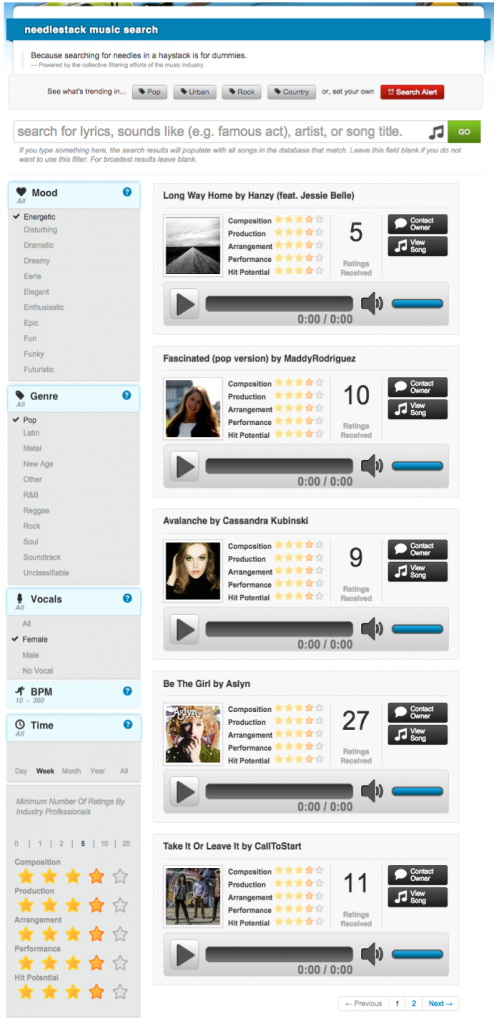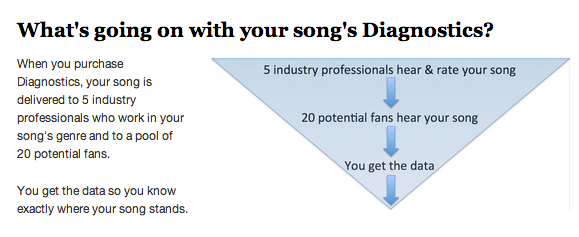Music Xray’s primary job is to find the needles in the haystack. A needle is any song or act deserving of being selected for any opportunity throughout the industry. Diagnostics insures we gather the information to enable us to do our best.
What is Diagnostics? Diagnostics is a one-time per song purchase that costs $10 and must be purchased for each song that is submitted directly to any opportunity or any industry professional on the site. Once Diagnostics has been purchased for a song it becomes “Diagnostics Exempt” and may be submitted to an unlimited number of opportunities without ever being required to purchase Diagnostics again.
Diagnostics serves two purposes:
1. It tells you where your music stands compared to other music that may be competing for similar opportunities. It generates recommended next steps based on the industry and fan reaction. And perhaps most importantly, it shows you the likelihood your music will be selected for an opportunity via the site, assuming you employ a best-practices submission strategy.
2. It tells the industry where your music stands and how to find it. Because Diagnostics enables us to gather enough information about your music to make it easily searchable for industry professionals in our industry-only search & discovery engine called Needlestack. This increases the chances your music has of being discovered by industry professionals who conduct searches for music with specific characteristics, such as high production quality, interesting hooks, mood, topic, etc.
We cover both purposes in detail below.
Purpose 1: To tell you where your music stands…
See the key for each item below the graphic:
A. The number of professionals who have heard and rated this song (at least 5 professionals rate the song upon your first submission – serious professionals from among our over 1500 professional users currently seeking songs and talent, so if the song blows one of them away, a deal or relationship may ensue and often does).
B. The average of the ratings received from industry professionals.
C. Where the song stands among all other songs that have been rated on Music Xray (hundreds of thousands).
D. The percentage of potential fans who after hearing the song for the first time became a direct fan (which provides that fan’s email address and Facebook profile link to the musician). As part of your first transaction with us, we send the song to a pool of 20 potential fans we’ve identified based on the fan’s music taste. We have a pool of tens of thousands of fans (and growing fast) who have signed up on Music Xray to discover new bands and songs.
E. Typically, we target potential fans from that pool for you (when there’s a match between the song and the fan’s taste profile) for $0.33 per fan. If 100% of those fans convert to direct fans of yours, the cost per acquired fan would be $0.33, but at a 35% conversion rate, that cost is $0.92 per acquired fan. A 35% conversion rate is not bad at all! The cost reflected here is what real contactable fans will likely cost you if you were to continue targeting fans on Music Xray. It’s up to you to decide what is acceptable to pay per acquired fan, based on your ability to monetize their fan base.
F. Based on the information in A. B. C. D. & E., we tell you the likelihood your song will be selected for an opportunity on the site. To reach this result, Music Xray uses machine learning algorithms and statistical probability calculations. It also requires the artist to employ a “best practices submission strategy”. To learn what that is and how we calculate the results, click here.
G. Based on the information in A. B. C. D. & E., we provide recommended next steps for submissions to opportunities and the industry professionals behind them. If the results are not encouraging, we recommend not to submit the song to further opportunities and sometimes we recommend you get song help improving the song. We make many top industry professionals on the site available to offer song critiques and career coaching.
H. Based on the information in A. B. C. D. & E., we provide recommended next steps for fan acquisition. If the data is not encouraging, we often recommend not continuing using the song to acquire fans.
I. This is the song activity chart that tells you what is happening with your song on the site at any time. Did you acquire a new fan? Was your song heard by an industry professional? Was your song displayed in a search result etc.
Purpose 2: To make your music searchable for the industry…
Music Xray offers industry professionals access to a sophisticated search engine called Needlestack Music Search.
Every day professionals use this search engine to find the best new music on the site. They usually do this by first seeking certain characteristics such as mood or a certain lyric phrase, or bpm – which are things you enter as meta data for your song. But then they filter for quality, so they look for songs that at least a few industry professionals have heard and that obtain good ratings on things like composition, productions, and hit potential. Each professional can decide which attributes are important and adjust the filters accordingly to find they songs that match their criteria.
Most professionals set the filters in Needlestack to display only the songs that have been heard by at least 5 industry professionals.
In other words, if your song hasn’t been heard by at least 5 professionals, it is unlikely to be found. That’s why Diagnostics obtains 5 industry ratings for your song, upon your first transaction on the site. And this is showing results. About half the deals between artists and the industry on Music Xray occur due to Needlestack music search.
Below is an image of Needlestack. Notice the search criteria settings. This particular search is showing:
All the energetic pop songs sung by females with a BPM range between 10 and 300 that in the past month have been heard by at least 5 industry professionals and that have received average ratings of at least 4 out of 5 stars on all criteria (composition, production, arrangement, performance, and hit potential.

Show me all the energetic pop songs sung by females with a BPM range between 10 and 300 that have been heard by at least 5 industry professionals in the past week and that get an average rating of 4 out of 5 stars on all criteria.


